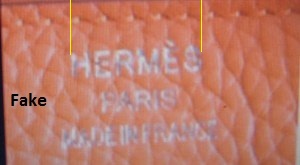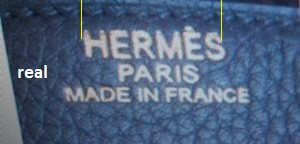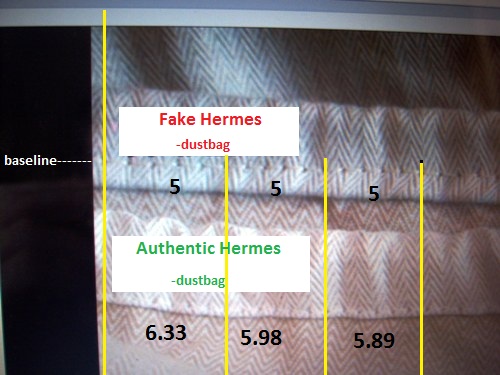Hermes label stamps are an important area of study when attempting to detect counterfeit signatures. There are distinct points concerning different attributes of the label stamp and the surrounding label area that we will focus in this section of the Hermes guide. The points of interest are:
- 1. [Stamp quality]: This refers to the quality of the stamp impression itself. Authentic Hermes should have a crisp and clear stamp.
- 2. [Logo font]: The stamp impression should conform the specific Hermes authentic font. Any deviation from the rigid font style should always raise red flags.
- 3. [Stitch line]: The stitch line point of interest concerns the seam line directly above the stamp impression. The detail that is important is the number of stitches that are counted in the length of the stamp. Fake Hermes will often times have a slightly differing number of stiches per label than the authentic bags. This is also a universal tool for spotting fake textile merchandise .
Below is a fake vs. real Hermes leather comparison:


- 1. The stamped logo impression on the fake bag is clearly a lower quality impression than that of the authentic Hermes on the right. Here we can see that the letters are much less clear and crisp in the leather. Also note the leather crease patterns are less complex than the authentic leather. More on Heremes leather can be found here.
- 2. The Hermes font in the fake stamp impression has some slight differences than the authentic font on the right. The most noticeable of those differences is the 'R' in Hermes. When compared, the fake's R appears to have a wider 'loop hole' than the authentic font. As well as an overall different shape altogether. (Also notice the distance the fake stamp is from the stitch line above). The fake logo is clearly positioned much lower than the authentic stamp.
- 3. The stitch line has been partitioned (marked with yellow lines) by using the width of the stamp as a reference point. This way both stitch lines can be accurately compared against the same baseline. In this case we find that the counterfeit Hermes has nearly five stitches (4.85) in the label partition compared to the authentic Hermes that has slightly over six stitches (6.1). This difference does not seem like much, but it is an indication of a possible counterfeit signature. More on using stitches per inch (SPI) methodology below.
Below is an real vs. fake Hermes Dustbag stitching comparison:

[Stitching]: What we did in this example is create partitions every 5 stitches of the fake Hermes dustbag and apply that distance to the authentic Hermes dustbag. This way we can compare the stitch counts per partition and look for inconsistencies. What we find is that the authentic dustbag has more stitches per partition than the fake. This is a good indicator of a possible counterfeit signature.
[SPI filter]: The stitch count method, (we call this the stitches per inch (SPI) filter), is a universal method applicable to all textile based goods. We have created a SPI calculation to better gauge these values. To better understand the technical aspect of what we are talking about, you may want to take a look here at the SPI argument. (If not, you should simply come away with the understanding that the stitch counts do matter, and further, that these values can often help us identify counterfeit items). Here are the results of the SPI calculation using the values obtained from the fake and authentic Hermes dustbag image.
- [Fake Hermes stitch count(average)]: (5+5+5)*1/3 = 5
- [Authentic Hermes stitch count(average)]: (6.33+5.98+5.89)*1/3 = 6.06
If we take the value of 5 for the fake dustbag and the value of 6.06 for the authentic and we enter these values into the SPI filter, we find that the fake is rejected.
Based on the average authentic value of 6.06, the SPI calculator gives us an acceptable stitch range of 5.05 to 7.27 stitches per partition. This means that we should expect the stitches per partition to fall within that range. Here we find that the fake (5) just misses the lower bound (5.05). This is very close.
(i) This test is not a 100% conclusive proof. Rather, this type of testing can provide us with some red flags, in which we would proceed with caution if we were considering purchasing this handbag. And certainly continue to scrutinize the other details of the handbag.
(ii) If we use the values from the example at the top of the guide, (from the label stamp comparison section), which gave us 4.85 for the fake, and 6.1 for the authentic, we find that the fake is also rejected from the filter. The range given in this case runs from 5.08 to 7.32, in which the fake label's stitch value (4.85) misses the lower bound (5.08).
Real vs. fake Hermes strap - stitch count


[Straps] The stamps on the authentic black Hermes strap represent: 1) on the left side the date code letter which gives the year of manufacturing, and 2) on the right side is the craftsman ID number, (Hermes are all hand made). For more detailed information on what the stamps on the straps signify go here.
Concerning the stitch counts, we can clearly see that the authentic stitch count, (if we count the stitches that run between the metal rivets), we find that the authentic black strap has 15 stitches, and the fake orange Hermes strap has 12. Here again we find that a lower stitch count is found on the fake strap when compared to the authentic strap.
References:
[1.] [youtube] theclosetae: http://www.youtube.com/watch?v=afbn5rgcqhs&feature=plcp
[2.] www.theclosetonlineshop.com
